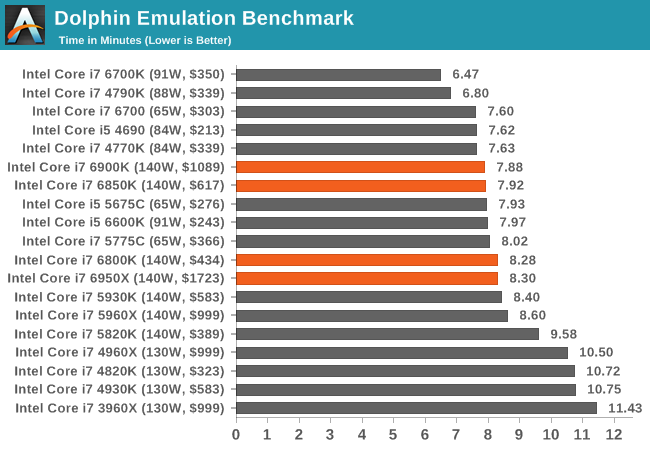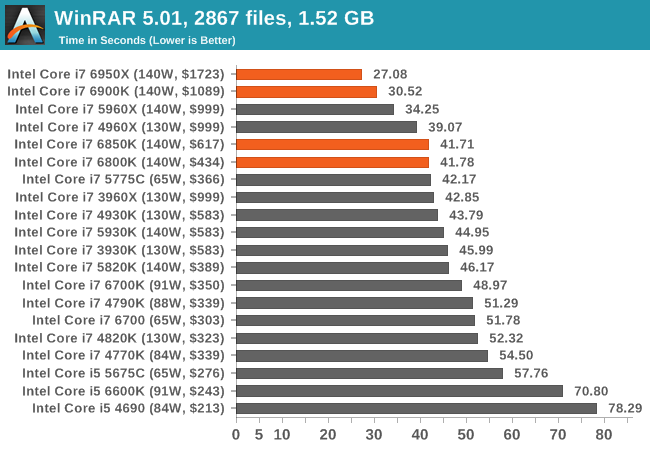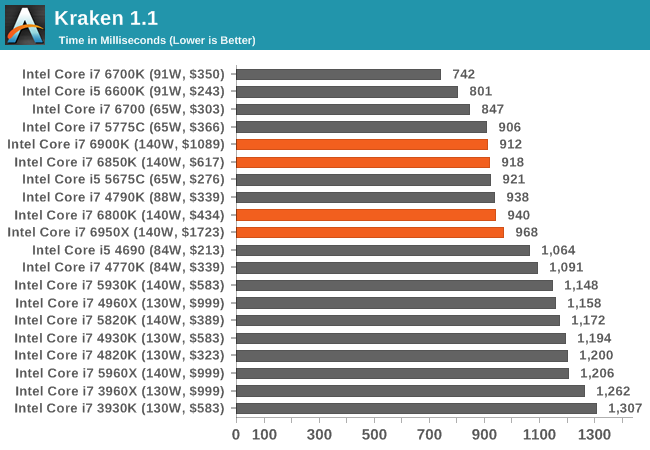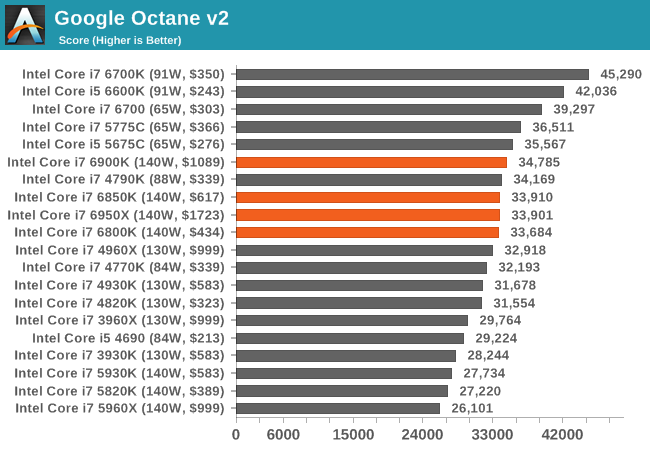The Intel Broadwell-E Review: Core i7-6950X, i7-6900K, i7-6850K and i7-6800K Tested
by Ian Cutress on May 31, 2016 2:01 AM EST- Posted in
- CPUs
- Intel
- Enterprise
- Prosumer
- X99
- 14nm
- Broadwell-E
- HEDT
Office Performance
Dolphin Benchmark: link
Many emulators are often bound by single thread CPU performance, and general reports tended to suggest that Haswell provided a significant boost to emulator performance. This benchmark runs a Wii program that ray traces a complex 3D scene inside the Dolphin Wii emulator. Performance on this benchmark is a good proxy of the speed of Dolphin CPU emulation, which is an intensive single core task using most aspects of a CPU. Results are given in minutes, where the Wii itself scores 17.53 minutes.

WinRAR 5.0.1: link
Our WinRAR test from 2013 is updated to the latest version of WinRAR at the start of 2014. We compress a set of 2867 files across 320 folders totaling 1.52 GB in size – 95% of these files are small typical website files, and the rest (90% of the size) are small 30 second 720p videos.

3D Particle Movement
3DPM is a self-penned benchmark, taking basic 3D movement algorithms used in Brownian Motion simulations and testing them for speed. High floating point performance, MHz and IPC wins in the single thread version, whereas the multithread version has to handle the threads and loves more cores.


Web Benchmarks
On the lower end processors, general usability is a big factor of experience, especially as we move into the HTML5 era of web browsing. As browsing moves into a multithreaded arena and web applications get more advanced, it is all the more important to have an appropriate level of performance.
Mozilla Kraken 1.1

Google Octane v2











205 Comments
View All Comments
Impulses - Tuesday, May 31, 2016 - link
Or just get a 5820K if you'd benefit from the extra cores... Or a 6600/6700K if you want the IPC bump for non gaming tasks and platform upgrades (USB 3.1, more lanes for M.2, etc).After throwing tick tock out the window it's unlikely the next refresh will be any more tempting. If you don't need any of the aforementioned things (more cores or platform upgrades) then you might as well sit tight tho.
rhysiam - Tuesday, May 31, 2016 - link
I've asked this question before and never got a good answer, so I'm trying again. Can someone explain to me why the boost clocks on the SKUs with more cores are always so much lower than those with fewer cores enabled?Base clocks have to be lower of course. I've got no issues with 10 active cores requiring lower clocks than 6 active cores, that makes sense. But what I don't get is why a 10 core SKU with 1 active core and 9 idle is somehow unable to turbo anywhere near as a 6 core implementation which is effectively 1 active core, 5 idle cores and 4 disabled cores on the same silicon . Is the power difference between those 4 idle & disabled cores really so significant on a 140W CPU that it necessitates an almost 10% lower clock speed?
It makes it even harder to justify spending $1.7K on a CPU when it looses so many benchmarks to CPUs costing a fraction of the price (including often the almost 3 year old 4820K).
RealLaugh - Tuesday, May 31, 2016 - link
I would like to know this too, I looked at the frequency and was surprised but I don't understand why it's like that.Also in the past Intel's top like Xeons have had hugh cache + core count but between 2-3GHz clock speeds only...
Ph0b0s - Tuesday, May 31, 2016 - link
Brief go at an explanation. Others can chime in to add on to my very simplistic explanation.The higher cored CPU's having lower clocks is down the to thermal envelope (referred to as TDW in watts) they are trying to hit on that CPU. Each core when working is effectively a heather on the CPU package. On CPU's with more cores, the heaters are more dense, i.e more heaters per area as they try to hit the same physical CPU package size whether 6 or 10 cores.
When all the cores are going a 10 core CPU will generate more heat than a 6 or 4 core CPU when the clocks are the same. To keep the 10 core CPU from hitting the thermal envelope limits that Intel put on them they decrease clock speed to offset the extra heat they are getting from the extra cores.
rhysiam - Tuesday, May 31, 2016 - link
Yes, but the "boost" clocks refer to single (or lightly) threaded workloads. Only one core is working. Your last paragraph refers to "when all the cores are going" - that's a base clock situation. As I said in my post I have no issue at all with 10 active cores requiring a lower frequencies than 6 in the same package. It's the single core taxed scenario I struggle to understand.adamod - Wednesday, June 1, 2016 - link
just a side note....my x5660's are rated at 2.8 base and 3.2 boost and with all 12 cores (dual socket setup) and 24 threads going 100 percent load and pulling 102W ea (while rated at 95W ea) mine NEVER get below 3.1ghz...i somehow got lucky as shit because i have two that can do it and only get to about 80C with the stock cooling on my hp workstation...sometimes you get lucky.....unfortunately i cant overclock though :(ThortonBe - Tuesday, May 31, 2016 - link
Perhaps it is like this. Not every transister has the same performance. When you increase the number of transisters (more cores) you increase the chance that you will get some slower transisters. For the turbo spec every core needs to be able to hit it.By making the turbo spec lower for higher core parts, Intel will have more parts that can be sold as the more expensive part (e.g. with ten cores they have a higher chance of fabricating a slow core than with six cores so they lower the max turbo on the ten cores to compensate to keep yields high).
Also, the floorplans (how the cores are wired up) might differ between the ten and eight core parts. In the GHz even the wiring can severely limit how high a frequency can be achieved. The more complex ten core designs are probably harder to wire up properly.
rhysiam - Wednesday, June 1, 2016 - link
The idea of tolerances with individual cores is an interesting suggestion I hadn't thought of.RE your last paragraph though, my understanding is that all 4 of these SKUs are identical chips, with the lower parts simply having cores (and PCIe lanes) disabled. That was certainly the case with Haswell-E CPUs and I'm assuming the same here. So the 10 core designs are exactly the same as the 6 core.
I suppose it's possible that the 6 core chips undergo testing and have their worst cores disabled, allowing higher turbo frequencies. It just seems, particularly with this generation, that the $1.7K flagship CPU is going to be such a low volume part anyway that they should be able to cherry-pick CPUs which can hit higher boost clocks.
Your suggestion would certainly explain why they're pursuing and promoting "turbo boost max 3.0." It seems like it's a bit of a mess at the moment, but if they can allocate single threaded workloads to the "best" core, surely they could start to hit much better boost clocks?
With Haswell the situation was even worse. You can buy a 4790K which can boost a single core to 4.4Ghz, but the best single threaded Haswell-E option (5930K), despite more the 50W additional TDP to play with and no iGPU for competition has to settle for a full 700mhz (16%) lower on the boost clock. I realise there's additional complexity with the "E" parts with larger cache and a wider memory bus, but that's a massive sacrifice to make that in many cases makes the cheaper 4790K the faster CPU, often by a wide margin.
I'd welcome other thoughts/comments/ideas here.
SAAB340 - Wednesday, June 1, 2016 - link
The 6950X will all have to be well binned to start with. They will all have to have the whole chip working and be able to do so at low voltage enough to meet the 140W TDP. If you have a leakier fully working chip it might still be sold as a 8 or 6 core version given that you just disable 2 or 4 (fully working but leaky) cores to meet the 140W TDP.The Turbo speed bins being lower in general the more cores you get on a CPU is certainly a function of that every individual core will have to be able to hit the highest turbo bin, even though it won't be TDP limited at that time. So you're pretty much guaranteed to be able to overclock to max single core turbo speed but you will most likely exceed the TDP.
It's just the same as that its way harder to find a hexa- octa- or deca-core chip able to reach xGHz overclock on all cores compared to finding a quad-core chip able to reach the same xGHz as 'only' 4 cores have to be good enough overclockers to reach it. The more cores, the less likely when we start to push the limits.
Turbo Boost Max 3.0 is certainly sounding like an interesting function where by the sound of it they instead try to identify the core that is able to run at the highest frequency. Here the opposite would be true, the more cores to choose from the higher likelihood to find one able to reach xGHz.
extide - Monday, June 6, 2016 - link
The floorplan does not differ. All 4 of these sku's use the exact same 10-core die. The lower end ones just have cores disabled, but otherwise they are the same exact silicon.